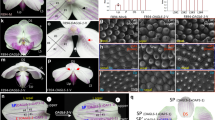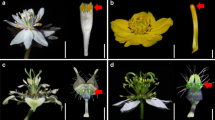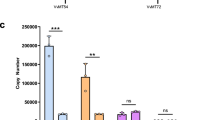Abstract
Orchidaceae, the orchid family under the order Asparagales, contains more than 20,000 accepted species in approximately 880 genera1–3. In contrast to most flowers of actinomorphic symmetry, orchid flowers typically have zygomorphic symmetry with a striking well-differentiated labellum (lip) that acts as the main pollinator attractant by employing visual, fragrance and tactile cues4–7. Genetics models controlling patterning formation of actinomorphic flowers, such as Arabidopsis, are well known. However, the mechanisms of sepal/petal/lip determination remain obscure. Here, we demonstrate a conserved principle, called the Perianth (P) code, which involves competition between two protein complexes containing different AP3/AGL6 homologues to determine the formation of the complex perianth patterns in orchids. In the P code, the higher-order heterotetrameric SP (sepal/petal) complex (OAP3-1/OAGL6-1/OAGL6-1/OPI) specifies sepal/petal formation, whereas the L (lip) complex (OAP3-2/OAGL6-2/OAGL6-2/OPI) is exclusively required for lip formation. This model is validated by the conversion of lips into sepal/petal structures in Oncidium and Phalaenopsis orchids through the suppression of the proposed L complex activity in lips using the virus-induced gene silencing (VIGS) strategy. A comprehensive examination of four different subfamilies of Orchidaceae further validates the P code and significantly extends the current knowledge regarding the mechanism and pathways of perianth formation in orchids.
This is a preview of subscription content, access via your institution
Access options
Subscribe to this journal
Receive 12 digital issues and online access to articles
$119.00 per year
only $9.92 per issue
Buy this article
- Purchase on Springer Link
- Instant access to full article PDF
Prices may be subject to local taxes which are calculated during checkout




Similar content being viewed by others
References
Cameron, K. M. et al. A phylogenetic analysis of the Orchidaceae: evidence from rbcL nucleotide. Am. J. Bot. 86, 208–224 (1999).
Chase, M. W., Cameron, K. M., Barrett, R. L. & Freudenstein, J. V. in Orchid Conservation (eds Dixon, K. M., Kell, S. P., Barrett, R. L. & Cribb, P. J. ) 69–89 (Natural History Publications, 2003).
Gorniak, M., Paun, O. & Chase, M. W. Phylogenetic relationships within Orchidaceae based on a low-copy nuclear coding gene, Xdh: congruence with organellar and nuclear ribosomal DNA results. Mol. Phylogenet. Evol. 56, 784–795 (2010).
Dressler, R. L. Phylogeny and classification of the Orchid family [electronic resource] (Dioscorides Press, 1993).
Rudall, P. J. & Bateman, R. M. Roles of synorganisation, zygomorphy and heterotopy in floral evolution: the gynostemium and labellum of orchids and other lilioid monocots. Biol. Rev. Camb. Philos. Soc. 77, 403–441 (2002).
Kocyan, A., Conti, E., Qiu, Y-L. & Endress, P. K. A phylogenetic analysis of Apostasioideae (Orchidaceae) based on ITS, trn L-F and mat K sequences. Plant Syst. Evol. 247, 203–213 (2004).
Cozzolino, S. & Widmer, A. Orchid diversity: an evolutionary consequence of deception? Trends Ecol. Evol. 20, 487–494 (2005).
Krizek, B. A. & Meyerowitz, E. M. The Arabidopsis homeotic genes APETALA3 and PISTILLATA are sufficient to provide the B class organ identity function. Development 122, 11–22 (1996).
Kramer, E. M., Dorit, R. L. & Irish, V. F. Molecular evolution of genes controlling petal and stamen development: duplication and divergence within the APETALA3 and PISTILLATA MADS-box gene lineages. Genetics 149, 765–783 (1998).
Hernandez-Hernandez, T., Martinez-Castilla, L. P. & Alvarez-Buylla, E. R. Functional diversification of B MADS-box homeotic regulators of flower development: adaptive evolution in protein-protein interaction domains after major gene duplication events. Mol. Biol. Evol. 24, 465–481 (2007).
Irish, V. F. Evolution of petal identity. J. Exp. Bot. 60, 2517–2527 (2009).
Hsu, H. F. & Yang, C. H. An orchid (Oncidium Gower Ramsey) AP3-like MADS gene regulates floral formation and initiation. Plant Cell Physiol. 43, 1198–1209 (2002).
Tsai, W. C., Kuoh, C. S., Chuang, M. H., Chen, W. H. & Chen, H. H. Four DEF-like MADS box genes displayed distinct floral morphogenetic roles in Phalaenopsis orchid. Plant Cell. Physiol. 45, 831–844 (2004).
Xu, Y., Teo, L. L., Zhou, J., Kumar, P. P. & Yu, H. Floral organ identity genes in the orchid Dendrobium crumenatum. Plant J. 46, 54–68 (2006).
Mondragon-Palomino, M. & Theissen, G. MADS about the evolution of orchid flowers. Trends Plant Sci. 13, 51–59 (2008).
Chang, Y. Y. et al. Characterization of the possible roles for B class MADS box genes in regulation of perianth formation in orchid. Plant Physiol. 152, 837–853 (2010).
Mondragon-Palomino, M. & Theissen, G. Conserved differential expression of paralogous DEFICIENS- and GLOBOSA-like MADS-box genes in the flowers of Orchidaceae: refining the ‘orchid code’. Plant J. 66, 1008–1019 (2011).
Pan, Z. J. et al. The duplicated B-class MADS-box genes display dualistic characters in orchid floral organ identity and growth. Plant Cell Physiol. 52, 1515–1531 (2011).
Su, C. L. et al. A modified ABCDE model of flowering in orchids based on gene expression profiling studies of the moth orchid Phalaenopsis aphrodite. PLoS ONE 8, http://dx.doi.org/10.1371/journal.pone.0080462 (2013).
Acri-Nunes-Miranda, R. & Mondragon-Palomino, M. Expression of paralogous SEP-, FUL-, AG- and STK-like MADS-box genes in wild-type and peloric Phalaenopsis flowers. Front. Plant Sci. 5, http://dx.doi.org/doi:10.3389/fpls.2014.00076 (2014).
Pan, Z. J. et al. Flower development of Phalaenopsis orchid involves functionally divergent SEPALLATA-like genes. New Phytol. 202, 1024–1042 (2014).
Chang, Y. Y., Chiu, Y. F., Wu, J. W. & Yang, C. H. Four orchid (Oncidium Gower Ramsey) AP1/AGL9-like MADS box genes show novel expression patterns and cause different effects on floral transition and formation in Arabidopsis thaliana. Plant Cell. Physiol. 50, 1425–1438 (2009).
Theissen, G. Development of floral organ identity: stories from the MADS house. Curr. Opin. Plant Biol. 4, 75–85 (2001).
Theissen, G. & Saedler, H. Plant biology. Floral quartets. Nature 409, 469–471 (2001).
Melzer, R. & Theissen, G. Reconstitution of ‘floral quartets’ in vitro involving class B and class E floral homeotic proteins. Nucleic Acids Res. 37, 2723–2736 (2009).
Smaczniak, C. et al. Characterization of MADS-domain transcription factor complexes in Arabidopsis flower development. Proc. Natl Acad. Sci. USA 109, 1560–1565 (2012).
Hsu, W. H. et al. AGAMOUS-LIKE13, a putative ancestor for the E functional genes, specifies male and female gametophyte morphogenesis. Plant J. 77, 1–15 (2014).
Hsieh, M. H. et al. Virus-induced gene silencing unravels multiple transcription factors involved in floral growth and development in Phalaenopsis orchids. J. Exp. Bot. 64, 3869–3884 (2013).
Hsieh, M. H. et al. Optimizing virus-induced gene silencing efficiency with Cymbidium mosaic virus in Phalaenopsis flower. Plant Sci. 201–202, 25–41 (2013).
Lu, H. C. et al. A high-throughput virus-induced gene-silencing vector for screening transcription factors in virus-induced plant defense response in orchid. Mol. Plant Microbe Interact. 25, 738–746 (2012).
Acknowledgements
This work was supported by grants to C-H.Y. from the National Science Council, Taiwan, ROC, grant number: NSC96-2752-B-005-007-PAE and NSC 100-2313-B-005-004-MY3. This work was also supported in part by the Ministry of Education, Taiwan, ROC under the ATU plan. We thank Drs Elena M. Kramer (Department of Organismic and Evolutionary Biology, Harvard University) and Kerstin Kaufmann (Institute of Biochemistry and Biology, University of Potsdam) for their helpful discussion of the results.
Author information
Authors and Affiliations
Contributions
C-H.Y. and H-F.H. developed the overall strategy, designed experiments and coordinated the project. H-F.H. and W-T.M. performed gene expression analyses. W-H.H., H-F.H. and J-Y.L. performed FRET analyses. Y-I.L., H-F.H. and C-H.Y. collected the orchid samples. Y-I.L. and H-F.H. performed the cryoscanning electron microscopy. H-F.H., W-T.M. and J-Y.Y. performed VIGS experiments. C-H.Y. and H-F.H. prepared and revised the manuscript.
Corresponding author
Ethics declarations
Competing interests
The authors declare no competing financial interests.
Supplementary information
Rights and permissions
About this article
Cite this article
Hsu, HF., Hsu, WH., Lee, YI. et al. Model for perianth formation in orchids. Nature Plants 1, 15046 (2015). https://doi.org/10.1038/nplants.2015.46
Received:
Accepted:
Published:
DOI: https://doi.org/10.1038/nplants.2015.46
This article is cited by
-
PeNAC67-PeKAN2-PeSCL23 and B-class MADS-box transcription factors synergistically regulate the specialization process from petal to lip in Phalaenopsis equestris
Molecular Horticulture (2024)
-
OAF is a DAF-like gene that controls ovule development in plants
Communications Biology (2023)
-
Regulatory network for FOREVER YOUNG FLOWER-like genes in regulating Arabidopsis flower senescence and abscission
Communications Biology (2022)
-
Multifunctional evolution of B and AGL6 MADS box genes in orchids
Nature Communications (2021)
-
Four DEF-like and two AGL6-like MADS-box genes display possible roles in perianth formation in Rhynchostylis retusa
Horticulture, Environment, and Biotechnology (2021)



